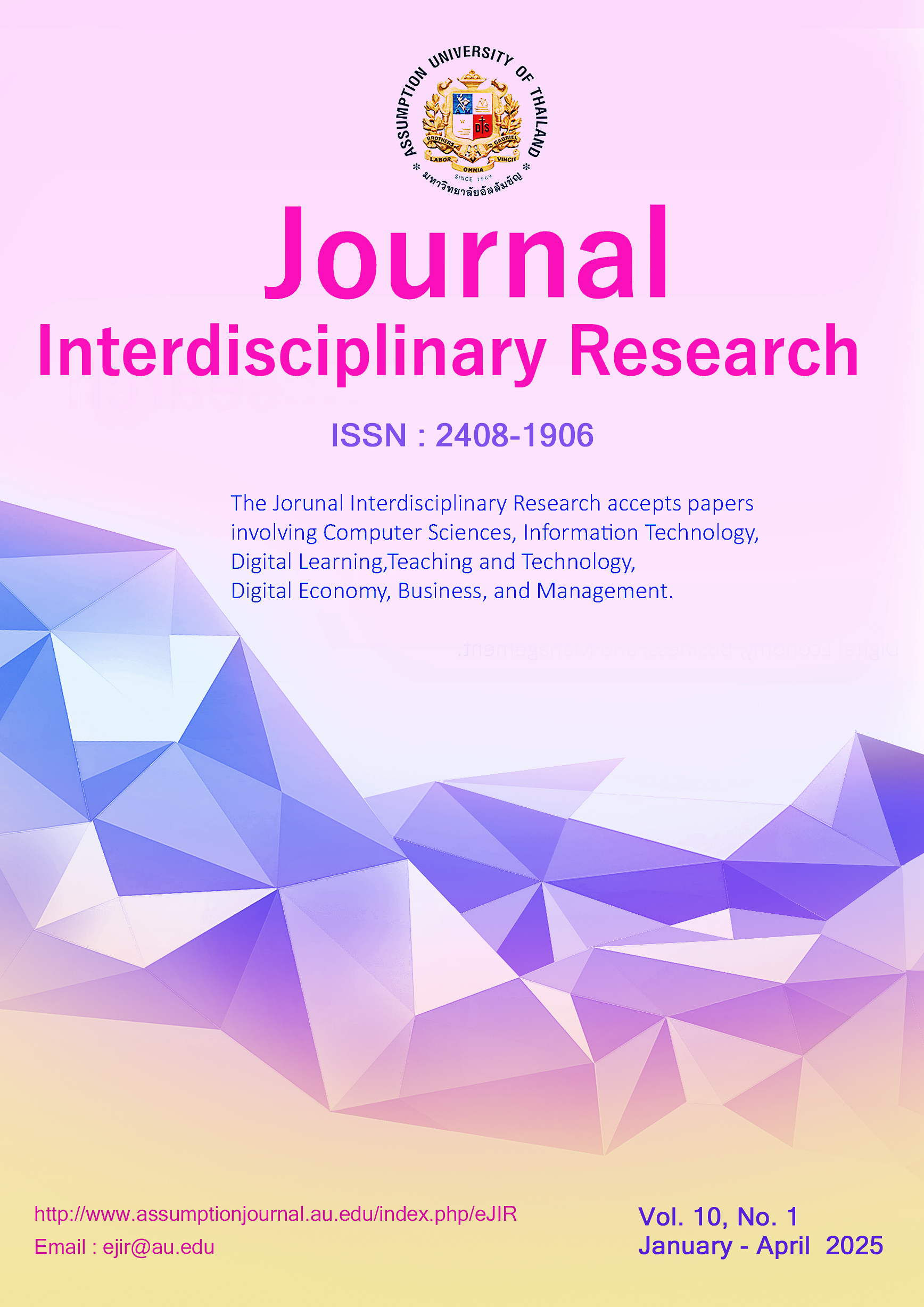Factors Impacting Students' Learning Behavioral Intentions with Online Teaching in Design Education: A Case Study of a Public University in Nanchang, China
DOI:
https://doi.org/10.14456/au-ejir.2025.5Keywords:
Learning Behavioral Intentions, Design Education, Online Teaching, Teaching Methods, Intervention Design ImplementationAbstract
Purpose: This study examines factors influencing students’ learning behavior intentions in online design education. It aims to enhance understanding of how online learning environments can be optimized to meet evolving educational needs. Research design, data and methodology: The study develops hypotheses and constructs a model based on current research and relevant theories. Data is obtained through a questionnaire survey, which is then statistically analyzed to test the proposed theoretical hypotheses. The methodology includes evaluations such as Item-Objective Congruence (IOC), Pilot Testing, and Multiple Linear Regression (MLR) analysis to assess the reliability and validity of the findings, focusing on perspectives from both teachers and students. Results: The study identifies key factors influencing students’ learning intentions in online design education, emphasizing the importance of communication, engagement, and the learning environment. Additionally, challenges such as the lack of face-to-face interaction and emotional connectivity are highlighted as significant barriers to effective learning. Conclusions: This study offers theoretical and empirical insights to improve online design education. Educators can apply these findings by fostering interactive learning spaces, incorporating real-time feedback, and using collaborative projects to enhance engagement. Recognizing these critical factors allows educators to refine their teaching strategies, foster motivation, and improve learning outcomes in online design education.
References
Ajzen, I. (1991). The theory of planned behavior. Organizational Behavior and Human Decision Processes, 50(2), 179-211. https://doi.org/10.1016/0749-5978(91)90020-T
Anderson, M. (2016). Teaching to learn: Communication practices for student engagement and understanding. Communication Education, 65(3), 341-361. https://doi.org/10.1080/03634523.2015.1101778
Anderson, T. (2008). The theory and practice of online learning (2nd ed.). AU Press.
Artino, A. R. (2009). Online learning: Are subjective perceptions of instructional context related to academic success? The Internet and Higher Education, 12(3-4), 117-125. https://doi.org/10.1016/j.iheduc.2009.07.003
Bates, A. W., & Poole, G. (2003). Effective teaching with technology in higher education: Foundations for success. Jossey-Bass.
Bodnar, M., Namieśnik, J., & Konieczka, P. (2013). Validation of a sampling procedure. Trends in Analytical Chemistry, 51, 117-126. https://doi.org/10.1016/j.trac.2013.06.011
Dhawan, S. (2020). Online learning: A panacea in the time of COVID-19 crisis. Journal of Educational Technology Systems, 49(1), 5-22. https://doi.org/10.1177/0047239520934018
Garrison, D. R. (2007). Online community of inquiry review: Social, cognitive, and teaching presence issues. Journal of Asynchronous Learning Networks, 11(1), 61-72.
Hair, J. F., Anderson, R. E., Tatham, R. L., & Black, W. C. (1995). Multivariate data analysis. Prentice-Hall.
Holmes, W., Bialik, M., & Fadel, C. (2019). Artificial intelligence in education: Promises and implications for teaching and learning. Center for Curriculum Redesign.
Kebritchi, M., Lipschuetz, A., & Santiague, L. (2017). Issues and challenges for teaching successful online courses in higher education: A literature review. Journal of Educational Technology Systems, 46(1), 4-29. https://doi.org/10.1177/0047239516661713
Komives, S. R., Lucas, N., & McMahon, T. R. (2009). Exploring leadership: For college students who want to make a difference. John Wiley & Sons.
Lee, E., & Hannafin, M. J. (2016). A design framework for enhancing engagement in student-centered learning: Own it, learn it, and share it. Educational Technology Research and Development, 64(4), 707-734. https://doi.org/10.1007/s11423-015-9422-5
Martin, F., & Bolliger, D. U. (2018). Engagement matters: Student perceptions on the importance of engagement strategies in the online learning environment. Online Learning, 22(1), 205-222. https://doi.org/10.24059/olj.v22i1.1092
McCulloch, A. (2016). The student as co-producer: Learning from public administration about the student–university relationship. Studies in Higher Education, 41(9), 1598-1610. https://doi.org/10.1080/03075079.2014.914914
Means, B., Toyama, Y., Murphy, R., Bakia, M., & Jones, K. (2010). Evaluation of evidence-based practices in online learning: A meta-analysis and review of online learning studies. Department of Education.
Meyer, M. W., & Norman, D. (2020). Changing design education for the 21st century. She Ji: The Journal of Design, Economics, and Innovation, 6(1), 13-49. https://doi.org/10.1016/j.sheji.2019.12.002
Nunnally, J. C., & Bernstein, I. H. (1994). The assessment of reliability (3rd ed.). McGraw-Hill.
Ooge, J., Dereu, L., & Verbert, K. (2023). Steering recommendations and visualizing its impact: Effects on adolescents' trust in e-learning platforms. 28th International Conference on Intelligent User Interfaces Proceedings, 1-15. https://doi.org/10.48550/arXiv.2303.00098
Peach, M., Ruiter, R. A. C., & Jones, A. (2017). Developing the storytelling skills of university students: An analysis of pedagogy and practice. Journal of Higher Education Outreach and Engagement, 21(3), 65-84.
Petherbridge, D., Bartlett, M., White, J., & Chapman, D. (2023). Instructional designers' perceptions of the practice of instructional design in a post-pandemic workplace. ODU Digital Commons.
Richardson, J. C., Maeda, Y., Lv, J., & Caskurlu, S. (2017). Social presence in relation to students’ satisfaction and learning in the online environment: A meta-analysis. Computers in Human Behavior, 71, 402-417. https://doi.org/10.1016/j.chb.2017.02.001
Sekaran, U., & Bougie, J. R. G. (2016). Research methods for business: A skill-building approach (5th ed.). Wiley.
Sharma, M., & Gupta, S. (2024). Enhancing online teaching methods through leadership innovations. ResearchGate. https://www.researchgate.net/publication/387139085_Enhancing_Online_Teaching_Methods_Through_Leadership_Innovations
Tarhini, A., Masa’deh, R., Al-Busaidi, K. A., Mohammed, A. B., & Maqableh, M. (2017). Factors influencing students' adoption of e-learning: A structural equation modeling approach. Journal of International Education in Business, 10(2), 164-182. https://doi.org/10.1108/JIEB-09-2016-0032
Tschannen‐Moran, M. (2001). Collaboration and the need for trust. Journal of Educational Administration, 39(4), 308-331. https://doi.org/10.1108/EUM0000000005493
Viberg, O., Cukurova, M., Feldman-Maggor, Y., Alexandron, G., Shirai, S., Kanemune, S., Wasson, B., Tømte, C., Spikol, D., Milrad, M., Coelho, R., & Kizilcec, R. F. (2023). What explains teachers' trust of AI in education across six countries?. arXiv preprint arXiv:2312.01627, 1-29. https://doi.org/10.48550/arXiv.2312.01627
Zawacki-Richter, O., Marín, V. I., Bond, M., & Gouverneur, F. (2019). Systematic review of research on artificial intelligence applications in higher education – where are the educators? International Journal of Educational Technology in Higher Education, 16(1), 39.
https://doi.org/10.1186/s41239-019-0171-0
Zhou, Z., & Dong, X. (2022). Research on online co-creation teaching and design of design courses in higher education. Design, 35(7), 80-83.
Downloads
Published
How to Cite
Issue
Section
License
Copyright (c) 2025 Jin Xin

This work is licensed under a Creative Commons Attribution 4.0 International License.
A separate Copyright Form will be sent to authors whose paper is accepted for publication.






